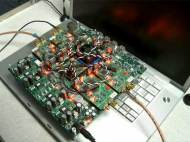Full-duplex technology enables double wireless capacity without new towers
 Rice University engineering researchers have made a breakthrough that could allow wireless phone companies to double throughput on their networks without adding a single cell tower. Instead using two frequencies to send and receive data, Rice’s new “full-duplex” technology allows wireless devices like cell phones and electronic tablets perform this communication with cell towers while being on the same frequency.
Rice University engineering researchers have made a breakthrough that could allow wireless phone companies to double throughput on their networks without adding a single cell tower. Instead using two frequencies to send and receive data, Rice’s new “full-duplex” technology allows wireless devices like cell phones and electronic tablets perform this communication with cell towers while being on the same frequency.
“Our solution requires minimal new hardware, both for mobile devices and for networks, which is why we’ve attracted the attention of just about every wireless company in the world”, said Ashutosh Sabharwal, professor of electrical and computer engineering at Rice University. “The bigger change will be developing new wireless standards for full-duplex. I expect people may start seeing this when carriers upgrade to 4.5G or 5G networks in just a few years.”
As we previously mentioned, current cell phones achieve two-way communications by using two different frequencies to send and listen. Rice’s team overcame this problem by employing an extra antenna and some computing tricks. Two signals are sent in a way which cancels each other at the receiving antenna. The canceling effect is purely local, and the other node is capable to receive the rest of the information.
“We repurposed antenna technology called MIMO, which are common in today’s devices”, said Sabharwal. “MIMO stands for ‘multiple-input multiple-output’ and it uses several antennas to improve overall performance. We took advantage of the multiple antennas for our full-duplex scheme, which is the main reason why all wireless carriers are very comfortable with our technology.”
Rice University is planning to roll all full-duplex innovations into their Wireless Open-Access Research Platform (WARP). WARP is a collection of programmable processors, transmitters and other gadgets that make it possible for wireless researchers to test new ideas without building new hardware for each test. Adding full-duplex to WARP will allow other researchers to start innovating on top of the breakthrough.
“We showed that our approach could support higher throughput and better link reliability than anything else that’s been demonstrated, which is a plus for wireless carriers”, said Sabharwal. “On the device side, we’ve shown that we can add full duplex as an additional mode on existing hardware. Device makers love this because real estate inside mobile devices is at a premium, and it means they don’t have to add new hardware that only supports full duplex.”
Sabharwal’s team went a step further and developed asynchronous full-duplex technology. It enables one wireless node to start receiving a signal while it’s in the midst of transmitting.
For more information, you can read the technical report titled: “Pushing the limits of Full-duplex: Design and Real-time Implementation”.









Leave your response!